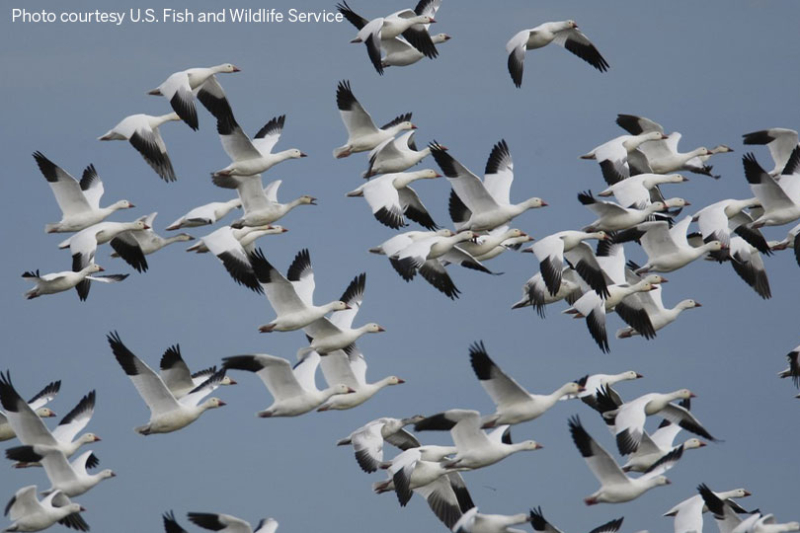By Jessica Domel
Multimedia Reporter
The drought and a decline in some geese numbers could make goose hunting a challenge in Texas this year.
Like other waterfowl, geese are attracted to fresh water on the landscape. In areas of Texas hard hit by drought, geese may be few and far between as they seek out fresh water and food.
“Obviously, they’re dealing with the same conditions (as ducks),” Kevin Kraai, waterfowl program leader for the Texas Parks and Wildlife Department (TPWD), said. “Geese are very, very tied to agriculture. Where we find geese in the state of Texas, there’s some kind of ag that is attracting them there—corn, wheat, milo, peanuts and rice.”
Geese feed in agricultural fields twice a day every day.
“If there’s water in those areas, obviously those birds are going to concentrate there,” Kraai told the Texas Farm Bureau Radio Network. “It’s kind of a known area where these birds are, and unfortunately, especially on our Texas coast, we’re seeing dramatic declines in birds coming and overwintering in Texas.”
The decline is significant enough that Kraai said they’re beginning to ask hunters and themselves questions about the future of goose management in Texas.
Although white-fronted geese are doing well continentally, there isn’t a great number of them in Texas.
“We’re now counting the fewest we’ve ever counted in the state of Texas,” Kraai said. “We barely counted 8,000 geese on the Texas coast last year when we used to count well over a quarter-million.”
Last year, the department only counted about 100,000 light geese on the Texas coast, down from 1.2 million a decade or two ago.
“These are things that we’re watching. There’s some reproductivity stuff going on with snow geese. They’re just not producing like they used to,” Kraai said. “It’s changing, and obviously, there’s wide-scale distributional shifts. Snow geese and white-fronts are running further northeast than us in the state of Texas these days.”
The declines have the department considering the removal of the Light Goose Conservation Order.
TPWD initially proposed removing the order in late 2022, but pulled back on the proposal in early 2023 to give TPWD staff and committees more time to consider the action.
“We’re definitely thinking about the future of light goose management for a lot of different reasons, but primarily the overall population of light geese has declined significantly, and few people know that,” Kraai said. “They still think they’re way overabundant and treat them with disrespect. They think they’re doing good to save the planet by doing certain things that are often times even illegal. So that’s a concern of ours.”
The Light Goose Conservation Order is not a hunting season. It is a management action that was enacted decades ago to allow hunters more opportunities to target light geese.
At the time, it was believed an overabundance of white geese at staging areas and breeding grounds in Manitoba Canada would lead to an ecological collapse.
Things have changed in the decades since the order was first implemented in Texas. Light goose populations in Texas are down significantly, and more is known about the carrying capacity of the breeding grounds in Canada.
“Looking back at how many birds we used to have, how many hunters we used to have, and how much harvest we used to have, it’s just a sad story,” Kraai said. “When all this started, we really were the ones prepared to assist, if you will, with this overabundant species. Obviously, there’s a lot going on with why snow geese are deciding not to come to Texas or at least stay. We’re dealing with habitat loss, changes in agriculture and land conversion. There’s a lot of things going on.”
One of those issues is increased harvest pressure as a result of the Light Goose Conservation Order.
“There’s an increase in harvest pressure, obviously increase in days available. We removed bag limits, made all kinds of other techniques legal that didn’t used to be legal, and that’s one of the reasons that we’re considering this or talking about all this is that that pressure, simply, they’re just not going to put up with it anymore,” Kraai said. “Wherever (the geese) are being pressured that hard, they’re just going to leave, and so one of the things we are considering is getting input from public over the next month or so, and then going back to our staff and advisory committees with some potential recommendations for our commission.”
There are some areas in Texas where geese continue to do well.
Cackling Geese primarily winter in the Texas Panhandle, and Kraai said they’re doing very, very well.
“Hunters are having a great success there,” Kraai said.
There’s also an area near Abilene where hunters can find speckle belly geese.
“There’s an area north of Abilene in Haskell County that has kind of become one of the finest goose hunting spots in all of North America, especially for speckle bellies. When they have water, there’s a bunch of peanuts and other crop fields that are very attractive to them,” Kraai said.
The light and dark geese hunting season in the west zone is Nov. 4-Feb. 4, 2024.
In the east zone, the season is Nov. 4-Jan. 28, 2024.
The Light Goose Conservation Order in the west zone is Feb. 5 to March 10. In the east zone, the additional hunting opportunities are from Jan. 29 to March 10.

